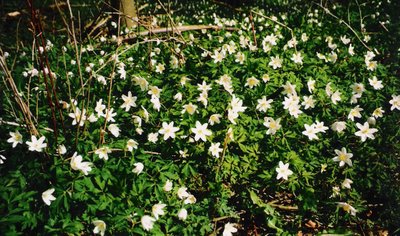
One of the first flowers of spring in the forest is the white anemone, spreading a lovely thick carpet of pure white flowers all over the forest floor, before the beeches come into leaf. The white anemone, Anemone nemorosa, is common in hardwoods. The name anemone origins from the Greek word anemos = wind. Denmark: Among many local names were feberurt (feverherb), spring lily and 'little white crow's feet'.The old herbalists called the Wood Anemone the Wood Crowfoot, because its leaves resemble in shape those of some species of Crowfoot. We also find it called Smell Fox. The specific name of nemorosa refers to its woodland habits.

In sunshine, the flower is expanded wide, but at the approach of night, it closes and droops its graceful head so that the dew may not settle on it and injure it. If rain threatens in the daytime, it does the same, receiving the drops upon its back, whence they trickle of harmlessly from the sepal tips. The way the sepals then fold over the mass of stamens and undeveloped seed-vessels in their centre has been likened to a tent, in which, as used fancifully to be said by country-folk, the fairies nestled for protection, having first pulled the curtains round them.

Folk medicine:
When the farmers in spring caught the sight of the first anemones, they eat at once three flowers as a protection against the dreaded cold fever (malaria) , and the flowers were also given to people, who already had this disease - and they were dried for use in winter. After having eaten the first three flowers , people had to say a magic verse and a prayer to God if he would protect them from the cold fever . White anemones crushed with egg white and salt were bound upon arteries against cold fever. Swelling feet had a bath in a decoction on white or blue anemone flowers. Only the flowers were used in folk medicine, since the juice from the plant was considered very poisonous. The plant was said to give the cattle bloody urine.Lineaeus says that cattle have been poisoned by eating it in the fresh state after having been underfed and kept on dry food during the winter, so that they were ready to browse on the first leaves they saw.

The Egyptians held the Anemone as the emblem of sickness, perhaps from the flush of colour upon the backs of the white sepals. The Chinese call it the 'Flower of Death.' In some European countries it is looked on by the peasants as a flower of ill-omen, though the reason of the superstition is obscure. The Romans plucked the first Anemones as a charm against fever, and in some remote districts this practice long survived, it being considered a certain cure to gather an Anemone saying, 'I gather this against all diseases,' and to tie it round the invalid's neck.
- Greek legends say that Anemos, the Wind, sends his namesakes the Anemones, in the earliest spring days as the heralds of his coming. Pliny affirmed that they only open when the wind blows, hence their name of Windflower, and the unfolding of the blossoms in the rough, windy days of March has been the theme of many poets:
- 'Coy anemone that ne'er uncloses
- Her lips until they're blown on by the wind.'
- Culpepper also uses the word 'windflower.' In Greek mythology it sprang from the tears of Venus, as she wandered through the woodlands weeping for the death of Adonis -
- 'Where streams his blood there blushing springs a rose
- And where a tear has dropped, a wind-flower blows.'

photo: grethe bachmann
No comments:
Post a Comment